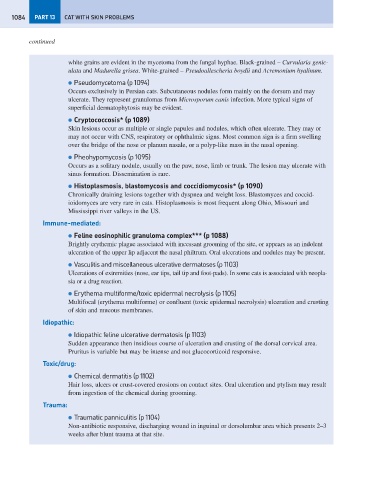Page 1092 - Problem-Based Feline Medicine
P. 1092
1084 PART 13 CAT WITH SKIN PROBLEMS
continued
white grains are evident in the mycetoma from the fungal hyphae. Black-grained – Curvularia genic-
ulata and Madurella grisea. White-grained – Pseudoallescheria boydii and Acremonium hyalinum.
● Pseudomycetoma (p 1094)
Occurs exclusively in Persian cats. Subcutaneous nodules form mainly on the dorsum and may
ulcerate. They represent granulomas from Microsporum canis infection. More typical signs of
superficial dermatophytosis may be evident.
● Cryptococcosis* (p 1089)
Skin lesions occur as multiple or single papules and nodules, which often ulcerate. They may or
may not occur with CNS, respiratory or ophthalmic signs. Most common sign is a firm swelling
over the bridge of the nose or planum nasale, or a polyp-like mass in the nasal opening.
● Pheohypomycosis (p 1095)
Occurs as a solitary nodule, usually on the paw, nose, limb or trunk. The lesion may ulcerate with
sinus formation. Dissemination is rare.
● Histoplasmosis, blastomycosis and coccidiomycosis* (p 1090)
Chronically draining lesions together with dyspnea and weight loss. Blastomyces and coccid-
ioidomyces are very rare in cats. Histoplasmosis is most frequent along Ohio, Missouri and
Mississippi river valleys in the US.
Immune-mediated:
● Feline eosinophilic granuloma complex*** (p 1088)
Brightly erythemic plague associated with incessant grooming of the site, or appears as an indolent
ulceration of the upper lip adjacent the nasal philtrum. Oral ulcerations and nodules may be present.
● Vasculitis and miscellaneous ulcerative dermatoses (p 1103)
Ulcerations of extremities (nose, ear tips, tail tip and foot-pads). In some cats is associated with neopla-
sia or a drug reaction.
● Erythema multiforme/toxic epidermal necrolysis (p 1105)
Multifocal (erythema multiforme) or confluent (toxic epidermal necrolysis) ulceration and crusting
of skin and mucous membranes.
Idiopathic:
● Idiopathic feline ulcerative dermatosis (p 1103)
Sudden appearance then insidious course of ulceration and crusting of the dorsal cervical area.
Pruritus is variable but may be intense and not glucocorticoid responsive.
Toxic/drug:
● Chemical dermatitis (p 1102)
Hair loss, ulcers or crust-covered erosions on contact sites. Oral ulceration and ptylism may result
from ingestion of the chemical during grooming.
Trauma:
● Traumatic panniculitis (p 1104)
Non-antibiotic responsive, discharging wound in inguinal or dorsolumbar area which presents 2–3
weeks after blunt trauma at that site.

